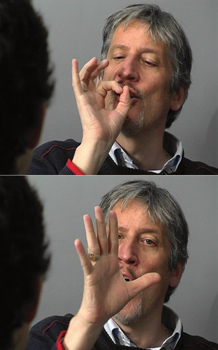
Padiglione Serbia
53a Esposizione Internazionale d'Arte - La Biennale di VeneziaZoran Todorovic
WARMTH
and
Katarina Zdjelar
BUT IF YOU TAKE MY VOICE, WHAT WILL BE LEFT TO ME?
Serbian Pavilion at the 53rd Biennale di Venezia
Commissioner and Curator: Branislav Dimitrijevic
Official inauguration:
"Padiglione Jugoslavia", Giardini di Castello,
6 June 2009 at 12h
Serbian pavilion at the 53rd Biennale di Venezia is open to become a space of dialogue between two art projects, thus far unrelated yet now jointly presented. Although they are artists of different generations, attitudes and philosophies, Zoran Todorovic (Belgrade, 1965) and Katarina Zdjelar (Belgrade, 1979), share a common point in arguing that an artist is a free mediator within the space of social interaction, and that artistic subjectivity emerges only if situated in the frictions of a world constructed from social matter. They share determination to locate what is identified as contemporary art in the web consisting of social structures and individual resistances, yet they are taking this shared determination in different directions.
For his project Warmth, Todorovic initiated systematic stockpiling of up to 2 tons of human hair. Hair was collected for months in hairdressing salons, but also in military barracks where hair-cutting is a norm of discipline, control or "social care". The conditions in which this process is carried out in a closed system are thoroughly documented, and this bio-waste is reused as the material for curious looking blankets which are amassed and made available for exhibition, utilization, inspection or hypothetically a DNA test in which each participating/inscribed body could perhaps be identified.
Todorovic always deals with modes of enacting bio-political control and explores the ways in which institutional spaces of control and punishment are inscribed in the body. He has been utilizing products/leftovers of the body as "raw-materials" for distressing counteractions. As in many of his previous projects, Todorovic explored his own scepticism towards ideas of social progress, emancipation and seemingly benevolent regulations, by questioning the norms of representation and participation; ethical and aesthetical standards.
On the other side, Katarina Zdjelar explores contrary processes of self-realization with all their paradoxes, promises and failures. As a foreign artist based in the Netherlands, she finds a way to situate her own experience of dislocation by investigating forms of regulated systems of communication and learning, rather than focus on the loss churned out by this dislocation. Language learning is of particular significance for her as this is a codified method of cultural integration not only involving a symbolic "rite of passage" of the uprooted individual, but also the corporeal affect shaping this "speaking body".
Her videos are examining norms of establishing personal relations from trying (and failing) to pronounce an other's name (There Is No Is), up to procedures of removing an accent in attempt to extract the 'foreignness' within a subject's speech (Perfect Sound). She also turned to situations in which a group effort is made to recover or improve abilities which are not motivated by dominant values of success and competition but rather consider an unwanted surplus of inadequacy, insecurity and ineffectiveness (Everything Is Gonna Be and A Girl, the Sun and an Airplane Airplane).
By juxtaposing two artistic positions, our intention is not to create a seamless space of cohesion and harmony. It is rather the opposite: to mark the contesting zones of contemporary art as artist-specific (as well as site-specific) and to gain something out of this relation/confrontation. It may still be our intention to represent what we understand as major concerns, as both specific to Serbian society but also to the larger world-in-crisis. Yet, we also suggest a way of sharing certain opposing worldviews articulated by different artistic approaches: one which energetically and methodically acts out and overtly identifies with its own space of fatalism, and one which by aiming simultaneously to our empathy and critical distrust shapes its own space of engagement.
Contact
Nataša Lazic (press) - natasa@msub.org.rs
Vesna Milic (co-ordination) - vesna@msub.org.rs
Museum of Contemporary Art
Boticeva 8, 11000 Belgrade, RS
+381 11 3676293
http://www.msub.org.rs
http://www.zorantodorovic.com
//katarinazdjelar.wordpress.com

